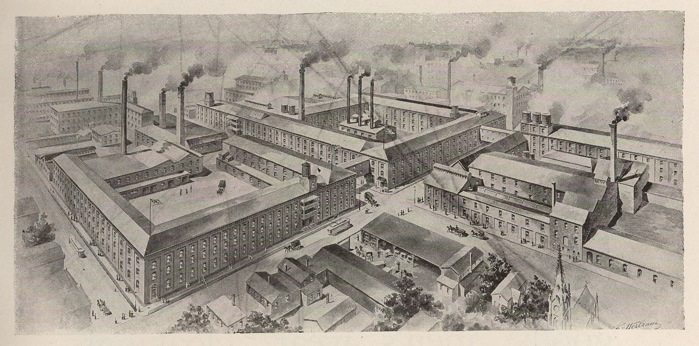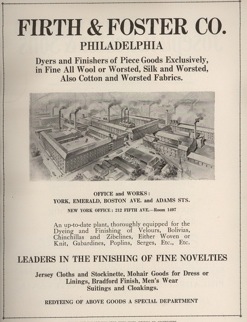
© Philadelphia Year Book (1917).
Providence Dye Works, c.1875
Emerald, Boston, and York Streets, Philadelphia PA 19125
© Carmen A. Weber, Irving
Kosmin, and Muriel Kirkpatrick, Workshop of the World (Oliver
Evans Press, 1990).
In 1866, John Firth was
listed in the city directory as a dyer on North 25th
Street. The firm of Firth & Brother located on
Emerald Street sometime between 1875 and 1877 on the site
of a former woolen mill. 1
By 1879, the firm
started finishing piece goods in addition to
dying. 2
Firth and Foster
Brothers, or the Providence Dye Works, covered over two
blocks and employed 240 hands, composed of men, boys, and
girls in 1889. The firm dyed, dried, and finished cotton,
woolen and worsted yarns, and warps, as well as piece
goods. 3
Its location made
the company accessible to the numerous textile firms
along Hagert (once Adams) Street. The expansion of this
large dye works along Emerald Street continued in the
early twentieth century; in 1912, the firm dyed and
finished piece goods of worsted, wool, and silk.
4
Firth and Foster
Company employed 367 people, mainly men, in 1916.
5
In 1943, Hart and
Foster Company still employed 353 workers at the Emerald
and York Street factory. 6
Only
portions of this large dye works still remain. The oldest
structure is 19346 Hagert Street. Constructed between
1881 and 1883, this three story brick building displays
brick pilasters, stone sills, and arched window openings,
with a corbelled brick cornice above the first floor
alterations. In 1889, the first floor of this building
contained a pattern dyehouse, with drying, pressing, and
tankering on the second floor; whereas the rear portion
along Boston Street held the drug room as well as a
dyehouse and areas for bleaching, finishing, sizing, and
drying. 7
Another three
story brick building along Emerald Street, built after
1889, echoes the details of the Hagert Street structure.
By 1912, Firth and Foster constructed the more elegant
building at the corner of Emerald and York Streets. This
three story brick building pairs the elements of the
earlier complex with a stone foundation, finished with
stone keystones containing the initial
‘F.’
1 Based on a comparison
between the 1875 Hopkins Atlas and Hexamer General Survey #1203 (1877)
"Providence Dye Works, Firth &
Brother."
2 Hexamer General Survey #1363 (1879)
"Providence Dyeing and Finishing Works, Firth,
Brothers & Co."
3 Hexamer General Survey #2295 (1889)
"Providence Dye Works, Firth & Foster
Bros."
4 The Philadelphia
Commercial Museum, Made in Philadelphia: Textile
Industries of Philadelphia, (Philadelphia, 1911), p.
24.
5 Department of Labor
and Industry, Pennsylvania, 1916, p. 1233.
6 Chamber of Commerce
and Board of Trade, Philadelphia, p. 39.
7 Hexamer General Survey #2295 (1889)
"Providence Dye Works, Firth & Foster
Bros."

© Philadelphia Year Book
(1917).
Update May
2007 (by
Torben Jenk):
The building west of Emerald
Street apparently burned around 2000. The building to the
east was demolished decades earlier and the site is now
occupied by Porretta's Frame & Alignment.
See
also:
Hexamer General Survey #1594 (1881)
"Providence Dyeing and Finishing Works, Firth Brothers
& Co."
Hexamer General Survey #1857 (1884)
"Providence Dye Works, Firth & Foster
Bros."